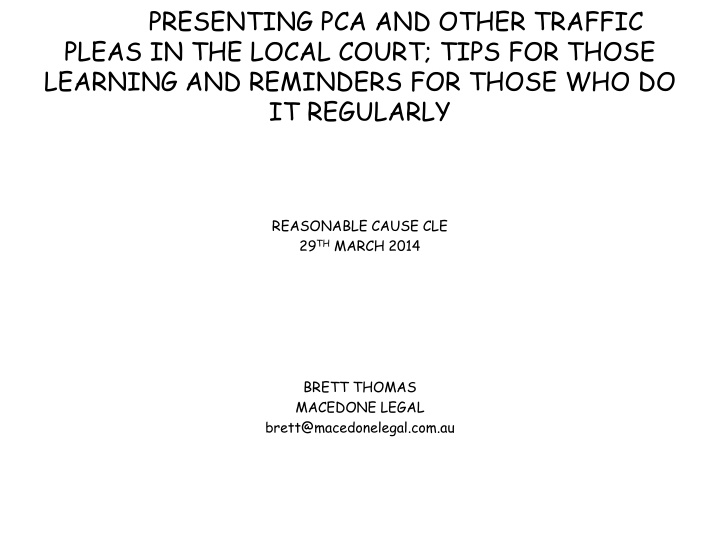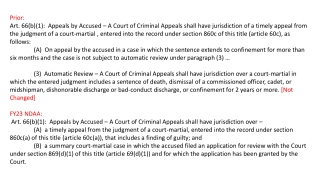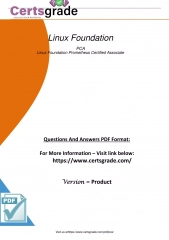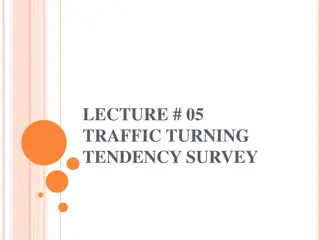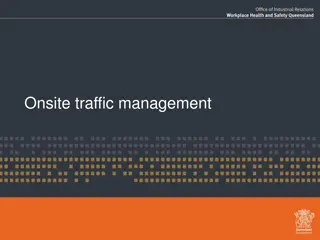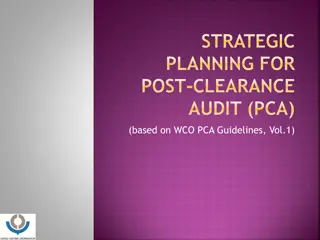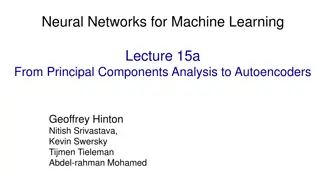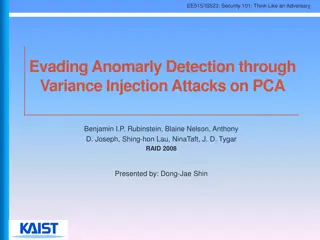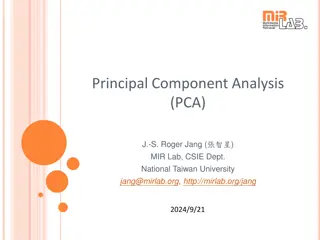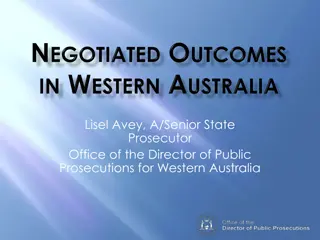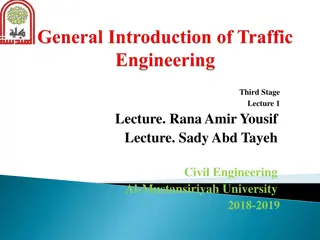Tips for Presenting PCA and Traffic Pleas in Local Court
Explore essential tips and reminders for presenting PCA and other traffic pleas in the local court from evidence preparation to sentencing considerations. Covering topics from alcohol alternatives to disqualification, this content offers valuable insights for legal professionals and learners alike.
Download Presentation

Please find below an Image/Link to download the presentation.
The content on the website is provided AS IS for your information and personal use only. It may not be sold, licensed, or shared on other websites without obtaining consent from the author.If you encounter any issues during the download, it is possible that the publisher has removed the file from their server.
You are allowed to download the files provided on this website for personal or commercial use, subject to the condition that they are used lawfully. All files are the property of their respective owners.
The content on the website is provided AS IS for your information and personal use only. It may not be sold, licensed, or shared on other websites without obtaining consent from the author.
E N D
Presentation Transcript
PRESENTING PCA AND OTHER TRAFFIC PLEAS IN THE LOCAL COURT; TIPS FOR THOSE LEARNING AND REMINDERS FOR THOSE WHO DO IT REGULARLY REASONABLE CAUSE CLE 29THMARCH 2014 BRETT THOMAS MACEDONE LEGAL brett@macedonelegal.com.au
A is for alcohol alternatives. Medicines, cough syrup, trifle. Evidence needed. Do not simply rehash instructions. A is also for appeal. But it is not simply going through the motions and then having a second bite of the cherry.
B is for breath analysis Within 2 hours. Not at place of abode. The initial reading entitles Police to arrest. The initial reading appearing on the facts sheet. B is also for beware of the Bench.
C is for criminality Where does it sit? Does it matter? The mid range of objective seriousness. Below. Above. Just below. Just above. Closer to the bottom than to the top. C is also for character; good and/or bad.
D is for disqualification. Mandatory on conviction. Automatic. The starting point. Minimum. Not the starting point. Second offence within 5 years. Outside the 5 years does not mean first offender. D is also for the dreaded extra 5 years (HTO) and the District Court.
E is for evidence. Support submissions with statements not references. Designated driver. Ill child or aged parent/s. The night before. The night itself.
F is for first offender 17 year old or 60 year old. No previous major offences. No previous criminal offences. Never been in a Court room. Arrest, detain, charged, printed. F is also for first plea of the day in a packed court room.
G 10 year anniversary on 8 September 2014. Howie J. It is a guideline not a straight jacket. The ordinary case Where does it sit? Less section 10 s. More section 12 s. The trickle down effect. is for Guideline Judgment
H is for Habitual Traffic Offender 3 offences within 5 years, including section 10 s. Any combination of 3 offences. Cumulative on Court imposed. Orphan periods. Applications to quash. When? Where? Will they be abolished ? I is also for Intensive Correction Order.
I is for interlock licence Not available with DWD or DWS. Discretionary. Appropriate or not appropriate. Public safety. The compliance period cannot be changed. The participation period can be extended but cannot be reduced. The specific orders to be made.
J is for journey. Let me take you on a journey. The facts come first. Then the traffic record. Then the subjective circumstances. Need for a licence. Include it all. Acknowledge the negatives.
K is for knowing your Bench Who is it ? What are they like ? What do they like ? What don t they like? Speak to the locals. Speak to the prosecutor. Sit and watch. No need to be first. Check beforehand and find out.
L is for local practice What is it? How does it work? Don t be first. Ask around. Go with the flow. Don t upset the locals. Duty probation & parole. TOP. L is also for licence or length of period off the road.
M is for the morning after. Low range or mid range? Surely not high range? Back it up with statements. Prove it. Does it help a person on zero blood alcohol level ?
N is for nonsense Do not simply rehash your instructions. Think about what you are saying. Is it necessary. Does it prompt intervention? Or just a raised eyebrow? N is also for non-conviction (section 10).
O is for feeling okay to drive. Think before you say it. Does it make sense?. Do you believe it? Because the Court probably won t. Where does it start and where does it finish? Depends on the reading.
P is for PSR Can be tremendously helpful. Needs to be positive. What do you do if it is not? Won t cover ICO (yet). Does client agree to everything? Need to cross examine the author. P is also for Parker direction.
Q is for quizzing the client Need to ask the questions. Then sort out the submissions. Can they back it up with evidence? Some information relevant some not. Q is also for being quizzed by the Court. (through you to your client).
R is for references. Never seen a bad one. Still need them. 3/4 good ones better than 10. Different font. Different format. Signed or email evidence. R is also for being realistic (get the pitch right).
S is for Section 10. Over used, under used, not used or misused ? I don t give Section 10 s Borderline. If it is bold then concede as much. I am instructed to ask S is also for suspended sentences.
T is for ten (section). 10(1)(a) or 10(1)(b). No demerit points. 2 year limit. Moving traffic offence. Discretion when breached. T is also for TBA.
U is for the up side. What is it? Talk about it but don t ignore the down side. Concede the down side. Keep it balanced. U is also for understanding.
V is for verbosity Don t engage in it. Say what needs to be said and sit down. If the Court indicates a particular result and it is on the money then enough said. If you need extra time then ask for it or warn the court (and your colleagues).
W is for waiting Sometimes worth it. Not always necessary to be first. Empty court room. W is also for waffle.
X is for cross examination Disputed facts and the need for evidence. Is it needed ? Is it something the court can ignore? Does it effect the overall outcome? Will it effect the penalty to be imposed? Do you call your client on a plea and expose them to cross examination?
Y is for yourself You have to come back another day. Your duty to the Court. Your duty to your client. Your working relationship with the Court and the prosecutors. You want(need) the Court to respect you (your integrity).
Z is for zero blood alcohol content How many times over the legal limit? Zero means zero. There is no special test. Z is also for zzzzz (the morning after)
